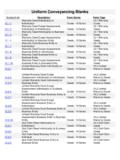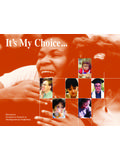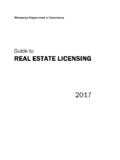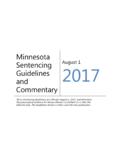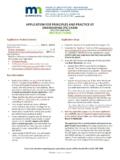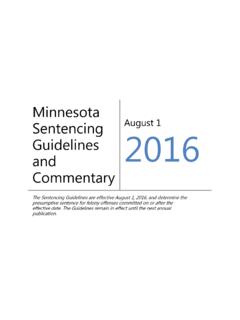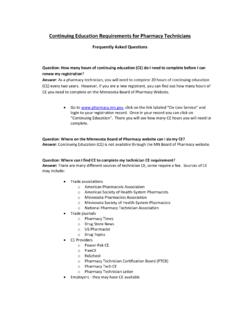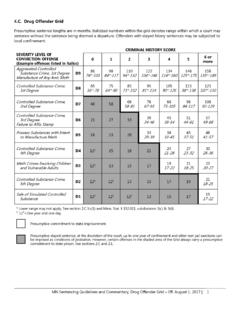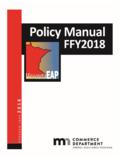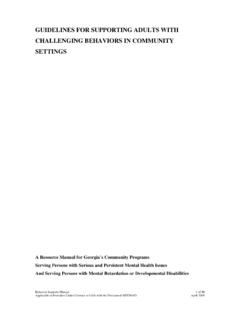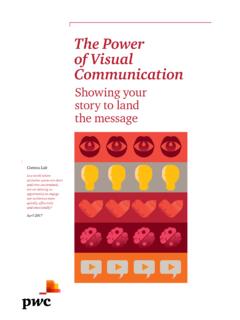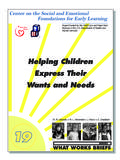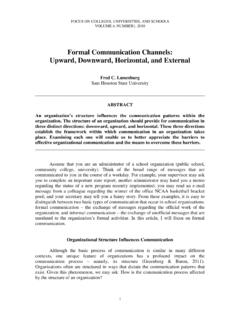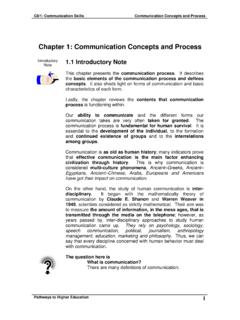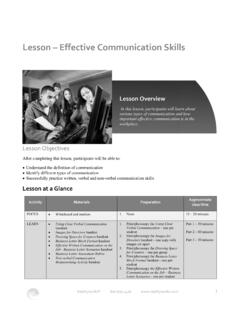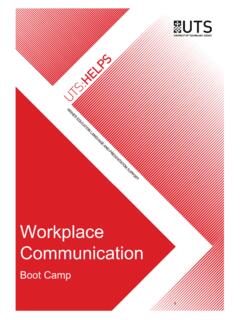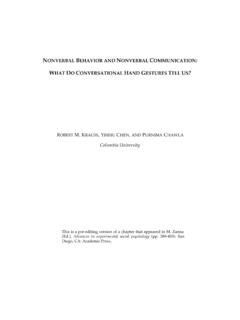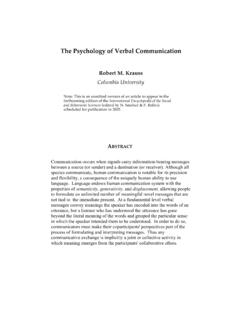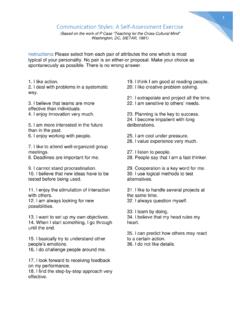Transcription of Language and Communication-Focused IEPs for Learners …
1 1 Language and communication - Focused IEPs for Learners Who Are Deaf or Hard of Hearing A DISCUSSION GUIDE Commission of Deaf, DeafBlind and Hard of Hearing Minnesotans 2015 1 Acknowledgments This document was developed by a team of Collaborative Stakeholders and the financial support from the Commission of Deaf, DeafBlind and Hard of Hearing Minnesotans. Discussion Guide Contributors: Kelly Anderson Metro Deaf School Melissa Buck- Northern Lights Special Education Cooperative Deanne Curran PACER Center Mandy Frederickson Metro Deaf School Carla Larson Duluth Public Schools Emily Manson St. Paul Public Schools Ann Mayes- Intermediate School District 917 Nanette McDevitt- Psychologist Greater Minnesota Launchpad Susan Meredith Minneapolis Public Schools Jody Olson Minnesota State Academies Anna Paulson- Commission of Deaf, DeafBlind and Hard of Hearing Minnesotans Susan Rose University of Minnesota Mark Schwartz- Minnesota State Academies Valerie Shirley Eden Prairie Public Schools Jody Waldo Intermediate School District 916 Language AND Communication-Focused IEPS FOR Learners WHO ARE DEAF OR HARD OF HEARING 2 2 Table of Contents Preface.
2 3 Introduction .. 4 Getting Ready for Language and Communication-Focused IEPs .. 5 What is the student s primary Language and communication mode at home and school? .. 6 How does the student s degree of hearing affect his or her Language and communication access?.. 7 What are the opportunities for direct communication and instruction in the student s primary Language / communication mode? .. 9 What specific data is available regarding the student s present level of academic and social Language ? ..11 For students with co-occurring disabilities, what is the range of Language and communication needs and abilities? ..13 What other educationally relevant needs resulting from the student s hearing loss must be addressed? ..15 What should be considered for students who are deaf or hard of hearing as they transition from high school to post-secondary education or the work force? ..17 Developing a Present Level of Academic Achievement & Functional Performance (PLAAFP) Statement.
3 21 Based on the needs identified in the PLAAFP, develop measurable annual Language and Communication-Focused goal(s) in the table below..22 References ..23 Appendix I: Federal Legislation Pertaining to Deaf and Hard of Hearing Student Special Education Needs ..24 Appendix II: Language and communication Assessments ..25 Appendix III: Sample Adaptations For A Student Who is Hard of Hearing with a Profound Sensorineural Hearing Loss in her Left Ear and a Mild High Frequency Sensorineural Hearing Loss in her Right Ear in the General Education Setting ..26 Appendix IV: Sample Language Communication-Focused Goal Pages for ELEMENTARY LEVEL Students ..27 Appendix V: Sample Language and Communication-Focused Goal Pages for SECONDARY LEVEL Students ..39 Appendix VI: Example Profiler Transition Checklist ..46 Language AND Communication-Focused IEPS FOR Learners WHO ARE DEAF OR HARD OF HEARING 3 3 Preface This Discussion Guide is designed to assist professionals serving students with varying degrees of hearing loss to develop Language and Communication-Focused individualized educational plans through the special education process.
4 Special Factors IV from the Individuals with Disabilities Education Act (IDEA) highlights the following: consider the communication needs of the chil d, and in the case of the chil d who is deaf or hard of hearing, consider the child s Language and communication needs, opportunities for direct communications with peers and professional personnel in the child s Language and communication mode, academic level, and full range of needs, including opportunities for direct instruction in the child s Language and communication mode. The Individual Education Program (IEP) includes considerations for students access to Language , mode of communication at home and at school, Language development and fluency abilities, communication partners, school placement and other environmental impacts on Language and communication needs. The purpose of this document is to provide a guide to help the IEP team consider the impact of hearing loss on the student s communication and Language access throughout the entire IEP process, including when planning for transition from high school to the post-secondary settings and work environments.
5 The format for the Discussion Guide, Language and Communication-Focused IEPs for Deaf and Hard of Hearing Learners , follows the model provided in the State of Minnesota Developing Standards-Based IEP Goals and Objectives (MDE, April 2013). The Discussion Guide will be reviewed and pilot tested with teachers serving students who are deaf, hard of hearing or deafblind. Teachers participating in the pilot testing will be asked to review the discussion prompts as an integral part of the IEP planning process and use the salient points for discussion and determination of development of a communication and Language focus throughout the IEP process. Language AND Communication-Focused IEPS FOR Learners WHO ARE DEAF OR HARD OF HEARING 4 4 Introduction All students must have the opportunity to fully participate in public education experiences. A critical aspect of participation is communication with others. Students who are deaf, hard of hearing, or deafblind arrive with a diverse set of unique Language patterns, communication modalities, and experiences that frequently do not match the expectations and assumptions about Language and knowledge of the typical educational curriculum and learning environment.
6 Hearing loss has a significant impact on a child s Language development and communication abilities, including social Language skills. Students with varying degrees of hearing loss frequently require specialized and direct instruction to develop functional pragmatic as well as academic Language and communication skills. Unilateral hearing loss or mild loss of hearing, due to colds or middle ear infections, can have a significant impact on a student s ability to fully access environmental auditory and linguistic information. This, in turn, can impact a student s academic performance and overall educational experience. Students who are deaf or hard of hearing often require explicit instruction in areas that students with intact hearing have incidentally acquired, such as basic information, including the days of the week, the name of the class pet, classmate names, directions, or the role of the school principal. The key components for an appropriate and effective individualized educational program (IEP) is the integration of Language and communication impact statements into the academic standards and the instructional delivery system.
7 The following components are vital to the IEP process: presenting a clear pic ture of the student's fluency in Language compared to his/her peers, the mode of communication used by the student both at home and school, the optimal instructional Language system, and the optimal social Language system. The questions and discussion prompts in this guide are designed to address the following considerations based on the Individuals with Disabilities Educational Act (IDEA) 2004 (Part 300/ ): student s Language and communication needs (identification of the student s primary mode(s) ofcommunication and/or primary Language ); for direct communication with peers and professional personnel in the student s languageand communication mode (availability of deaf/hard of hearing peers and adult role models in the student scommunication mode/ Language ); for direct communication in the student s Language and communication mode in academics(evidence that all educational options for communication and placement are presented and explained.)
8 Provision for communication accessibility for academic instruction, school services and extracurricularactivities in the student s primary Language and communication mode as appropriate for the requirements have been posed in the form of questions for discussion by the IEP team members. The team is encouraged to follow the topical questions in the order they are proposed. Each of the questions provides a scaffold while addressing the communication and Language needs for each student. The questions may be adapted to accommodate the needs of the student and his or her family. Addressing each of the five primary questions will ensure that the IEP requirements are considered and addressed for each student s individual needs. The questions incorporate IEP Language -based goals, specialized instruction, accommodations, and specialized needs. Use of the discussion questions, notes and resources may assist parents and teachers of deaf and hard of hearing students to effectively communicate with other IEP participants who may not be familiar with the multifaceted impact of hearing loss on Language development, communication , as well as the diversity of individual student needs.
9 Space is provided at the end of each question to make notes that can translate into a Language and communication - focused IEP, with reference to the Minnesota Language and communication Checklist. Examples of interpretations of the laws can be found in the following court cases: of Education of Hendrick Hudson Central School District v. Rowley, 458 176 (1982)[ ]. v. Tustin Unified School District, No. 11-56259 (2013)[ ] v. Douglas County (PDF) [ ] Language AND Communication-Focused IEPS FOR Learners WHO ARE DEAF OR HARD OF HEARING 5 5 Getting Ready for Language and Communication-Focused IEPs Members of the IEP team must consider the need for Language and Communication-Focused IEP goals as well as the significance of compromised or lack of auditory access to communication . These considerations need to be infused in the development of the IEP when considering needs, goals and accommodations to ensure appropriate placement and provision of services. Specific data must be presented regarding the impact of the child s degree of hearing on Language and communication and the student s present levels of academic and social Language .
10 The team can then discuss the student s full range of Language and communication skills and other educationally relevant needs to determine the learning progressions needed to close any gaps between the student s present skill levels and grade-level content standards/benchmarks. For secondary level students who are deaf or hard of hearing, this discussion will also include transition area skills and access to information specific to post-secondary and work settings. Opportunities for direct communication with adults and peers, role models, and instruction in the student s primary Language or communication mode must also be considered. Language is central to the human experience. communication is essential for social and academic progress. It is important to consider that the unique nature and consequences of hearing loss indicate that students who are deaf or hard of hearing have a common need for communication access as well as individualized need areas.
